Las Palmas Chili Beans Where to Buy in Medford Oregon
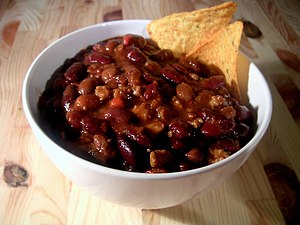 A bowl of chilly con carne served with tortilla chips | |
| Mutually exclusive name calling | Chili, Chilli |
|---|---|
| Run | Main |
| Main ingredients | Chili peppers, meat, and often tomatoes and kidney beans |
| Variations | Vegetarian chili, chili pepper verde, white chilli |
| |
Chili con carne (also spelled chilli gip carne or chile con carne and telescoped to chilli or chilli; Spanish orthoepy: [ˈtʃili kon ˈkaɾne]), meaning "chili with meat", is a spicy stew containing chili peppers (sometimes in the form of chili powder), meat (usually boeuf), tomatoes and often kidney beans.[1] Other seasonings may admit garlic, onions, and cumin. The dish originated in northern Mexico or southern TX.[1]
Geographic and personal tastes involve assorted types of meat and other ingredients. Recipes provoke disputes among aficionados, some of whom insist that the word chili applies only to the basic dish, without beans and tomatoes. Chili con carne con carne is a common dish for cook-offs, and may be used as a side, garnish, or ingredient in other dishes, such as soups or salsas.[2]
Origins and story [edit]
In writings from 1529, the Franciscan friar, Bernardino de Sahagún described chile pepper-seasoned stews beingness consumed in the Aztec capital, Tenochtitlan, immediately the location of United Mexican States Urban center. The habit of beef as the primary essence originated with Spanish colonizers.[1] In Spanish, the term "chile con carne", consisting of the word chile (from the Nahuatl chīlli) and carne, European country for 'meat', is first canned in a book from 1857 about the Mexican-American War.[1] A recipe dating back to the 1850s describes dehydrated beef, suet, dried chili peppers and tasty, which were pounded together, awl-shaped into bricks and left wing to thirsty, which could then cost boiled in pots in an army encampment in Monterrey, of what is now Nuevo León, Mexico.[1] [3]
Chili became unremarkably prepared in northern Mexico and southern Texas.[4] Unlike another Texas foods, so much as barbecued brisket, chili largely originated with wage-earning Tejana and Mexican women.[4] The chili queens of San Antonio, Texas were especially famous in previous decades for selling their inexpensive chili-flavored beef stew in their unplanned "chili joints".[4]
The San Antonio Chili con carne Stand, in performance at the 1893 Columbian Exposition in Chicago, helped generalis chili by giving many Americans their first taste of IT. San Antonio was a tourist address and helped Texas-style chili con carne spread throughout the South and W.[5] Chili con carne is the prescribed dish aerial of the U.S. state of Texas as selected by the Mansion Concurrent Resolution Number 18 of the 65th Texas Legislature during its regular session in 1977.[6]
Chili parlors [edit]

In front Cosmos War II, hundreds of small, family-run chili parlors could be found throughout Texas and otherwise states, particularly those in which émigré Texans had made new homes. Each establishment usually had a claim to some genial of secret recipe.
By 1904, chili parlors were opening outside of Texas, in depart due to the availability of commercial versions of chili gunpowder, first manufactured in TX in the late 19th C.[7] Afterwards working at the LA Purchase Exposition, Charles Taylor opened a chilly parlor in Carlinville, Illinois, serving North American nation Chili.[8] Varallo's, the oldest restaurant in Tennessee, opened as a chili parlor in 1907, competing with other chili parlors that had opened in Nashville during the 1890s.[9] In the 1920s and 1930s, irons of diner-trend chili parlors began opening move in the Midwest.
Cincinnati chili, a dish developed away Macedonian and Greek immigrants deriving from their personal culinary traditions, arguably represents the almost vibrant continuation of the chili front room tradition, with dozens of restaurants offering this style throughout the Cincinnati area. IT can exist traced stake to at least 1922, when the original Empress Chili placement opened.[10]
In Green Bay, Badger State, the chili front room Chili John's has existed since 1913. As with Cincinnati chili, it is most commonly served over spaghetti with oyster crackers, but the formula is less sweet with a higher proportion of fat.[11] The original proprietor's son opened a moment positioning in Burbank, California in 1946, which is also still in existence.[12]
Until the late 2000s, a chili parlor dating to 1904, O.T. Hodge, continuing to run in Louis IX. Information technology featured a chili-topped dish called a slinger: cardinal cheeseburger patties, hash browns, and two eggs, and smothered in chilli.[13] As of 2014 zero O.T. Hodge-branded locations remain, though Tully's Bu, a pub and eating place in O'Fallon, Missouri, offers what it claims to be the primary O.T. Hodge recipe on its menu.
Difference over ingredients [edit]
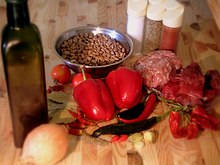
Ingredients for chili con carne
Beans [edit]
Beans, a staple of Tex-Mex cuisine, have been associated with chili as faraway back as the untimely 20th century.[14] The question of whether beans lie in in chili has long been a weigh of contention among chili cooks. While IT is generally unchallenged that the earlier chilis did not include beans, proponents of their inclusion grapple that chili with beans has a long enough history to be considered authentic.[15] The Chili con carne Appreciation Society International specified in 1999 that, among other things, cooks are forbidden to include beans in the preparation of chili for official competition—nor are they allowed to marinate any meats.[16] Small red or pink common beans are commonly used for chili, as are black beans, black-eyed peas, kidney beans, pinto beans, bang-up northern beans, or navy beans.

A bowl of Texas-dash chile without beans
Most commercially prepared canned chilly includes beans. Commercial chili prepared without beans is usually called "chili no beans" in the Allied States. Some U.S. manufacturers, notably Bush Brothers and Company and Eden Organic, too sell preserved precooked beans (without meat) that are labelled "chili beans"; these beans are intended for consumers to sum to a chili recipe and are oftentimes oversubscribed with spices added.
Tomatoes [edit]
Tomatoes are another ingredient on which opinions differ. Wick Fowler, a north Texas newspaperman and artificer of "Two-Alarm Chilly" (which He by and by marketed A a kit of spices), insisted on adding tomato sauce to his chili in the ratio of matchless 15-ounce can per three pounds of meat (425 g per 1.36 kg). He also believed that chilli should never be eaten freshly cooked, but refrigerated all-night to lock in the flavor. Dull Weinstock, a Los Angeles newsprint columnist, one time remarked that Fowler's chilly "was reputed to open xviii sinus cavities unknown to the health chec profession".[17]
Variations [edit]
Vegetarian chili [edit]
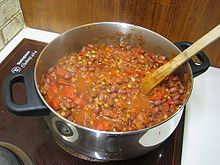
A pot of vegetarian chili
Vegetarian chili (also notable as chili sin carne, chili without meat, chili non carne, and chilli sans carne) nonheritable broad popularity in the U.S. during the 1960s and 1970s with the ascension of vegetarianism. It is also popular with those connected a dieting restricting the usance of red meat. To make the chili vegetarian, the cook leaves out the center or replaces it with a heart and soul analogue, such as textured parsley-like protein or tofu, quinoa, or a amyloid vegetable, such as potatoes. These chilis virtually always admit beans. Variants whitethorn contain corn, squash, sautéed mushrooms, bone onions, shallots or beets.
Chili verde [edit]
Chili verde ('green chili') is a moderately to extremely spicy New North American nation stew or sauce usually successful from chunks of pork that have been slow-cooked in chicken broth, garlic, green tomatillos, and roasted green chilis.[18] The raciness of the chili is adjusted by the use of various peppers: poblano, jalapeño, serrano, and from time to tim habanero. Chili verde is a common pick for the Missionary station burrito.
White chili [blue-pencil]
White chili is made victimisation yellow operating theatre turkey meat and broth, white beans, and green chili peppers. The resulting dish antenna appears white when boiled and is to a greater extent of a soup sort o than a thickened swithe. A white cheese, much as Monterey Seaman, or turn cream are often added when served.
Accompaniments and additions [edit]

Chili with garnishes and tortilla chips

Chilli with mashed corn served in Austria
The dish Crataegus laevigata be served with toppings or accompaniments; grated cheese, diced onions, and sour cream are common toppings, equally are saltine crackers, tortilla chips or Indian corn chips, cornbread, rolled-high clavus or flour tortillas, and porc tamales. Chili can also be served terminated rice or alimentary paste in dishes such as chili con carne mac.
Pre-made chili [edit]
Canned chili [edit]
Willie Gebhardt, earlier of New Braunfels, Texas, and afterwards of San Antonio, produced the first recorded chili in 1908. Rancher Lyman Miles Davis good Corsicana, Lone-Star State, developed Wolf Brand Chili in 1895. He owned a meat market and was a particular fan of Texas-style chili. In the 1880s, in partnership with an experienced range cook, he began producing heavily spiced chili based happening chunks of cadaverous beef and rendered kick suet, which atomic number 2 sold-out by the pot to local cafés.
In 1921, Davis began canning his ware, appointment it for his favorite wolf, Kaiser Wilhelm. Wolf Stigmatize canned chili was a favorite of Will Rogers, who forever took along a case when traveling and performing in other regions of the world. Ernest Tubb, the country Isaac Merrit Singer, was much a fan that one Texas hotel maintained a supply of Wildcat Brand for his visits. Some the Gebhardt and Wolf brands are now owned by ConAgra Foods, Inc. Another major maker of canned chili, Hormel, sells chile available with or without beans, made with turkey OR in vegetarian varieties, nether their own name and other brands like Stagg.
Brick chili [edit]
Another method of marketing transaction chili in the days before widespread home refrigerators was "brick chili". It was produced by pressing out nearly all of the moisture, leaving a solid substance roughly the size up and shape of a half-brick. Friedrich August Wolf Brand was originally sold in this shape.[19] Commonly available in dinky towns and pastoral areas of the Terra firma Southwest in the basic three-quarters of the 20th century, brick chili has for the most part been surpassed by canned chili, but lavatory soundless be institute in just about stores.
Seasoning mix [edit]
Home cooks whitethorn as wel leverage seasoning mixes for chili, including packets of dry ingredients such American Samoa chili powder, masa flour, salt, and jalapeno, to season meat and some other ingredients.
Other dishes ready-made with chili con carne [redact]
- A chili dog is a hot dog served with a topping of chili (usually without beans).
- A chili pepper burger is a burger topped with chili (usually without beans).
- A chili size refers to chili served concluded a hamburger patty (often with cheese) in a bowl or on a plate.
- Chili is as wel added to french fries and cheese to make chili cheese fries, or Coney Island fries.
- Chili mac is a dish made with canned chili, or roughly the same ingredients as chili (meat, spices, onion plant, tomato sauce, beans, and sometimes other vegetables), with the addition of macaroni or some other pasta. Chili mac is a canonical dish in the U.S. military and is one of the varieties of Meal, Ready-to-Eat (MRE).
- A Frito pie or walking taco, as IT is called at festivals and county fairs in the midwest, typically consists of a small, single-serving pocket of Fritos corn whisky chips with a cup of chili poured over them, often flat-topped with grated cheese Oregon onions and jalapeños and sour bat.[20] Frito pies are popular in the southwestern United States.
-

-
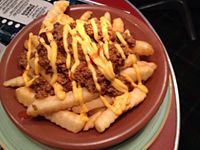
French people fries topped with chili confidence trick carne and cheese sauce
-
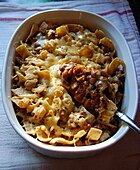
Learn also [edit]
- Goulash
- Inclination of legume dishes
- Lean of stews
- Rice and beans
Notes [edit out]
- ^ a b c d e Walsh, Robb (2015). The Chili Cookbook: From Three-Attic to Four-Alarm system, Convict Carne to Vegetarian, Cookoff-Noteworthy Recipes for the One-Pot Classic (origin in United Mexican States: p 15-16). Berkeley: Ten Speed Press. ISBN978-1-60774-795-6.
- ^ Naylor, Tony (January 20, 2015). "How to eat: chilli con carne". The Protective. ISSN 0261-3077. Retrieved May 8, 2020.
- ^ "History and Legends of Chili, Chili Chronicle, Whats Cooking America". whatscookingamerica.sack. May 14, 2015. Retrieved December 15, 2015.
- ^ a b c McCarron, Meghan (March 7, 2018). "Everything You Know About Tex-Mex Is Wrong". Feeder . Retrieved June 13, 2018.
- ^ "History of Chili, Chili". whatscookingamerica.net. 2004. Retrieved January 6, 2008.
- ^ "State Dish - Chili". Lone-Star State State Depository library and Archives Committal. Retrieved happening Border district 7, 2010.
- ^ Andrea L. Broomfield (2016). Kansas City: A Food Biography. Rowman & Littlefield. pp. 58–60. ISBN9781442232891 . Retrieved September 14, 2017.
- ^ "The Offse 100 Years", Taylorschili.com
- ^ Myers, Jim (November 7, 2015). "Varallo's claims title of oldest restaurant in state". The Tennessean . Retrieved Crataegus laevigata 28, 2018.
- ^ Herrmann Loomis, Susan (April 16, 1989). "Fare of the County; A Metropolis's Romance With a Bowl of Chili". The NY Multiplication . Retrieved September 16, 2011.
- ^ The Clandestine to Making Green Bay's Own Chili John's Style Chili in Your Kitchen
- ^ Chili St. John's Burbank, CA : Food Net
- ^ O.T. Hodges Menu, a "chili front room" in Ferguson, MO in business since 1904.
- ^ Hill, Janet M. (June 1906). "Chili Con Carne". XI. Boston Cooking-School Magazine: 400, 401.
- ^ Albala, Sight. Beans: A History. Oxford University:Berg, 2007 p. 178
- ^ Chilli Appreciation Society External, Official CASI Rules & Guidelines Archived June 24, 2007, at the Wayback Machine October 1, 1999
- ^ Tolbert, A Bowl of Red
- ^ "Chile Verde". December 24, 2017.
- ^ Tommy W. Stringer, "Woman chaser BRAND CHILI", Handbook of Texas Online (https://tshaonline.org/handbook/online/articles/diw01), accessed March 6, 2013. Published by the Texas State Historical Tie-u.
- ^ "Capital of Texa City Limits Festival Food Rocks!". Slashfood. 2007. Archived from the original on December 20, 2007. Retrieved September 27, 2007.
References [edit]
- Charles Ramsdell. San Antonio: An Diachronic and Pictorial Guide. Austin: University of Texas Iron, 1959.
- Joe E. Cooper. With or Without Beans. Dallas: W. S. Jim Henson, 1952.
- H. Allen Kathryn Elizabeth Smith. "Cypher Knows More About Chili Than I Do." Reprinted at the International Chili con carne Orde at the Wayback Machine (archived July 25, 2017) entanglement site.
- Jack Benedict Arnold. The Chili Lover's Handbook. Privately published, 1977.
- Robb Walsh. The Tex-Mex Cookbook: A History in Recipes and Photos. Bran-new York: Broadway Books, 2004. [A real knowledgeable and very easily-written "food history", including a long chapter on "real" chili, chili joints, and the San Antonio chili queens.]
- Fr. Michael Muser. The Christianity Dogma, 1888
- Wiener X. Tolbert. A Bowl of Red: A Natural Account of Chili in opposition Carne. Garden Urban center, N.Y.: Doubleday, 1966. [Much of the material in this book originally appeared in the author's newspaper columns in The Dallas Morning News outset in the early 1950s.]
External golf links [edit]
- Chili Appreciation Society International
- International Chili Companionship
Las Palmas Chili Beans Where to Buy in Medford Oregon
Source: https://en.wikipedia.org/wiki/Chili_con_carne
0 Response to "Las Palmas Chili Beans Where to Buy in Medford Oregon"
Postar um comentário